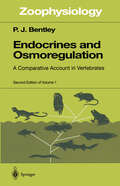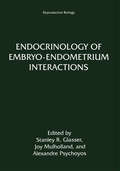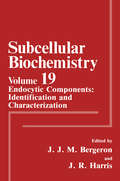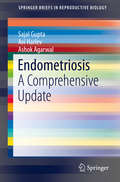- Table View
- List View
Endocrines and Osmoregulation: A Comparative Account of the Regulation of Water and Salt in Vertebrates (Zoophysiology #39)
by P.J. BentleyFrom a review of the previous edition: "I strongly recommend it as an essential reading and reference book for younger and older workers alike". Nature
Endocrines and Osmoregulation: A Comparative Account in Vertebrates (Zoophysiology #39)
by P.J. BentleyFrom a review of the previous edition: "I strongly recommend it as an essential reading and reference book for younger and older workers alike". Nature
Endocrinology of Embryo—Endometrium Interactions (Reproductive Biology)
by Stanley R. Glasser Joy Mulholland Alexandre PsychoyosEarly embryonic loss is a continuing social and economic global problem. In human populations the estimates of interruptions early in pregnancy range from 35-60%. In animal husbandry (swine, ruminants) fully 30% of pregnancies fail to survive early events of gestation. The futility associated with this persistant high risk is even more unsettling because of advances made in assisted reproductive technology which, although this very selective methodology has added to our knowledge of embryo-endometrial interactions, has resulted in a birth rate of only 14%. These studies have instigated comparisons of the live relative contributions of the embryo and the uterus to the outcome of pregnancy. These analyses have shown that we have learned significantly less about the role of the uterus in deciding the outcome of either natural or assisted pregnancies. In 1979 a quotation by George Corner was used to set the tone of a meeting that was devoted to discussion of the cellular and molecular aspects of implantation. In spite of the proliferation in research activity which occurred in the following 15 years our real understanding of the embryo transfer process has fallen short of our expectations. We use the Corner quotation, once again, to preface this symposium so that we may recall that the fundamental nature of the process which regulates embryo-endometrial interactions still escapes us.
Endocytosis: From Cell Biology to Health, Disease and Therapy (Nato ASI Subseries H: #62)
by A. Dautry-Varsat J. Gruenberg L. Mata M. Marsh A. Ryter B. Van Deurs(Director: Pierre J. COURTOY) Two years after its first gathering in Oeiras, Portugal, the European Endocytosis Group convened for a second workshop at the Pasteur Institute, Paris, on October 1-5, 1990. The meeting is reported in detail in this volume; a preliminary coverage, based on the overviews of each session, has appeared in the New Biologist (1991, 3:243-252). The three main objectives, to broaden the audience, to present a more comprehensive view of the multiple aspects of endocytosis, from basic biology to health, disease and therapy, as well as to clarify controversial issues, have been largely fulfilled. The Second European Workshop on Endocytosis was attended by more than tOO participants, originating from 18 countries. 59 lectures and 35 posters were presented. In addition, vivi~ roundtables allowed to thoroughly discuss the dynamics and the regulation of the endocytic apparatus, as well as the role of endocytosis in antigen presentation. Endocytosis is a general and distinctive property of all eukaryotic cells, including protists, plants and fungi.
Endocytosis and Signaling (Progress in Molecular and Subcellular Biology #57)
by Christophe Lamaze Ian PriorThis book focuses on the context dependency of cell signaling by showing how the endosomal system helps to structure and regulate signaling pathways. The location and concentration of signaling nodes regulate their activation cycles and engagement with distinct effector pathways. Whilst many cell signaling pathways are initiated from the cell surface, endocytosis provides an opportunity for modulating signaling networks’ output. In this book, first a series of reviews describe the endocytic and endosomal system and show how these subcellular platforms sort and regulate a wide range of signaling pathway components and phenotypic outputs. The book then reviews the latest scientific insights into how endocytic trafficking and subcellular location modulate a set of major pathways that are essential to normal cellular function and organisms’ development.
Endocytosis in Plants
by Jozef ŠamajEndocytosis is a fundamental cellular process by means of which cells internalize extracellular and plasma membrane cargos for recycling or degradation. It is important for the establishment and maintenance of cell polarity, subcellular signaling and uptake of nutrients into specialized cells, but also for plant cell interactions with pathogenic and symbiotic microbes. Endocytosis starts by vesicle formation at the plasma membrane and progresses through early and late endosomal compartments. In these endosomes cargo is sorted and it is either recycled back to the plasma membrane, or degraded in the lytic vacuole. This book presents an overview of our current knowledge of endocytosis in plants with a main focus on the key molecules undergoing and regulating endocytosis. It also provides up to date methodological approaches as well as principles of protein, structural lipid, sugar and microbe internalization in plant cells. The individual chapters describe clathrin-mediated and fluid-phase endocytosis, as well as flotillin-mediated endocytosis and internalization of microbes. The book was written for a broad spectrum of readers including students, teachers and researchers.
Endofullerenes: A New Family of Carbon Clusters (Developments in Fullerene Science #3)
by T. Akasaka Sh. NagaseTo the eyes of a chemist, carbon is certainly one of the most fascinating elements of the periodic table. Basically, the electronic structure and atomic size of carbon enables this element to form a variety of bonds with other elements and, most importantly, with other carbon atoms as weIl. These unique features lead to the amazingly complicated molecular structures we encounter e. g. in life sciences and organic chemistry. Of course, the technical importance of carbon is enormou- but I don't want to carry too many coals to Newcastle. Prom the viewpoint of an astrophysicist or chemist, the significance of carbon lies in the fact that it is the most abundant condensable element in space. Born in the interior of stars, and from there expelled into the interstellar medium, it initiates the formation of simple and complex molecules and of nanoscopic grains. These in turn form huge clouds in space - the birthplace of new stars and planetary systems. The decisive role of carbon in interstellar chemistry is widely accepted and the search for more and more families of interstellar carbon-bearing molecules is a topic of ongoing research. The interdisciplinary aspect of carbon also concerns its various solid forms, in which C and the other closed-cage fullerenes are certainly some of the most popular 60 newcomers.
Endogenous and Exogenous Regulation and Control of Physiological Systems
by Robert B. NorthropFrom a biomedical engineering perspective, this book takes an analytic, quantitative approach to describing the basic components of physiological regulators and control systems (PRCs). In Endogenous and Exogenous Regulation and Control of Physiological Systems, the author provides grounding in the classical methods of designing linear and nonlinear systems. He also offers state-of-the-art material on the potential of PRCs to treat immune system ailments, most notably AIDS and cancer. The book focuses on certain "wet" physiological regulators, such as those using endocrine hormones as parametric control substances. Endogenous and Exogenous Regulation and Control of Physiological Systems includes simulations that illustrate model validations and the putative control of cancer and HIV proliferation. It explores novel, untried immunotherapies on the cutting-edge of PRC treatment and explores the latest technologies.
Endogenous and Exogenous Regulation and Control of Physiological Systems
by Robert B. NorthropFrom a biomedical engineering perspective, this book takes an analytic, quantitative approach to describing the basic components of physiological regulators and control systems (PRCs). In Endogenous and Exogenous Regulation and Control of Physiological Systems, the author provides grounding in the classical methods of designing linear and nonlinear systems. He also offers state-of-the-art material on the potential of PRCs to treat immune system ailments, most notably AIDS and cancer. The book focuses on certain "wet" physiological regulators, such as those using endocrine hormones as parametric control substances. Endogenous and Exogenous Regulation and Control of Physiological Systems includes simulations that illustrate model validations and the putative control of cancer and HIV proliferation. It explores novel, untried immunotherapies on the cutting-edge of PRC treatment and explores the latest technologies.
The Endogenous Energy-Saving Technological Change in China's Industrial Sector
by Xubo HeAs improving energy efficiency and increasing energy R&D investment may be the main means for China's industrial sector to achieve sustainable growth, this book attempts to unify energy use efficiency and energy R&D inputs into a standardized economic analysis framework. By distinguishing between energy R&D inputs and non-energy R&D inputs, this book draws on the research paradigm of neoclassical economics to clarify the basic concepts and endogenous mechanisms of energy-saving technological progress as a logical starting point. Under the framework of the existing endogenous growth theory analysis, the heterogeneous R&D inputs are divided into two different mechanisms that affect energy use efficiency, namely factor substitution effect and energy-efficient input increase effect, and a heterogeneous R&D input is constructed. This book constructed an analytical framework for endogenous energy-saving technological progress in the industrial sector based on heterogeneous R&D inputs; it established a mathematical model for the endogenous energy-saving technological advancement of the industrial sector based on heterogeneous R&D inputs; it estimated the energy-saving technological progress rate of 37 Chinese industrial sub-sectors from 1980 to 2010; fourth, it has empirically examined the relationship between the heterogeneous R&D investment in China's industrial sector and its energy-saving technological advancement rate.
Endogenous Market Structures and the Macroeconomy
by Federico EtroThis is a key year for the evolution of international markets. The global economy is experiencing the most severe downturn since the thirties, it is temporarily leaving a path of sustained growth that characterized the last decades, and is facing an impressive decline of trade between countries. Banks are going bankrupt, the stock market has crashed, rms are going out of bu- ness or drastically reducing their production and exports, workers are being red and investment in new business creation or innovation is shrinking. Meanwhile, consumers con dence has dropped at its minimum, aggregate demand has been declining for months and expansionary policies and int- national coordination have failed to counteract the crisis until now. It is quite likely that all this will change sooner or later, but at the end of this crisis our understanding of the macroeconomy may change as well. In front of these crucial events, this book is not an attempt at proposing a radically new way of interpreting macroeconomic phenomena, and, as a m- ter of fact, it is not even a book on macroeconomic theory. My more modest goal is to collect a number of insights derived from recent research on the role of competition and innovation in the analysis of three topics: business cycles, trade and growth through innovations.
Endogenous Opioids: From Basic Science to Biopsychosocial Applications (Advances in Neurobiology #35)
by Patrick L. Kerr Cristian Sirbu John M. GreggThis new volume provides a scientifically based exploration of the multifaceted world of endogenous opioids, including endorphins, enkephalins, dynorphins, endomorphins, and orphanin FQ/nociceptin, featuring a strong translational focus. Topics covered range from basic scientific investigations, to clinical applications, to investigations in areas such as oncology, childbirth, and disordered eating, to psychosocial contexts such as volunteering and positive emotions. One of the main goals of Endogenous Opioids is to provide recommendations for new directions in medical research and health policy that are rooted in sound scientific research.
Endogenous Stem Cell-Based Brain Remodeling in Mammals (Stem Cell Biology and Regenerative Medicine)
by Marie-Pierre Junier Steven G. KernieThis text highlights the endogenous regenerative potential of the central nervous system in neonates and juveniles and discusses possible ways it might be manipulated for medical purposes. The first section provides a descriptive summary of the salient steps of human brain development with a discussion of comparisons with other mammalian brains. It also provides a historical perspective on our understanding of ongoing brain development throughout the lifespan and serve to introduce the concept of brain plasticity following injury. The second part is devoted to the endogenous reparative potential of the brain, including its limitations, and articles focusing on defined pathologies (e.g. anoxia/hypoxia, epilepsy, traumatic brain injury and stress) in animal models and in humans pinpoint eventual ways these pathologies might be manipulated. The third and final focuses on the "dark side" of stem cells for brain repair or of the manipulation of spontaneous adaptive events after injury (e.g. genomic instability, sensitization to cancerous transformation and defective neural networks).
Endohedral Fullerenes: Electron Transfer and Spin (Nanostructure Science and Technology)
by Alexey A. PopovThis book discusses recent progress in endohedral fullerenes – their production and separation techniques, as well as their characterization and properties. Furthermore, the book delves into the all-important issue of stability by investigating electron transfer between the encapsulated metal species and the carbon cage. It also reviews spin-based phenomena caused by the shielding of endohedral spin by the fullerene, and analyzes formation of the spin states by charge transfer as studied by electron spin resonance. Tuning of charge states of endohedral species and of spin states of both the cage and the cluster are explained. Finally, the book considers the recent discovery of magnetism in some endohedral fullerenes, and the potential for quantum computing.
Endohedral Lithium-containing Fullerenes: Preparation, Derivatization, and Application
by Yutaka Matsuo Hiroshi Okada Hiroshi UenoThis book describes the emergent endohedral metallofullerene, lithium-containing fullerene Li@C60, with an overview from its history to recent application research. The book covers synthesis, preparation, purification, structure, physical and chemical properties, derivatization, computational theoretical studies, and device application of Li@C60. Readers can learn cutting-edge nanotechnology of this exotic nanocarbon material, which is expected to deliver future solutions in clean energy and bio devices. This work is by a researcher who has long experience in carbon nanomaterials—more than 15 years with his contributing coworkers. The level of the book is appropriate for graduate students, post-docs researchers, and young faculty members who are interested in nanomaterials from the point of view of chemistry and physics.
Endohedral Metallofullerenes: Basics and Applications
by Xing Lu Luis Echegoyen Alan L. Balch Shigeru Nagase Takeshi AkasakaKnowledge on endohedral metallofullerenes (EMFs) has increased dramatically during the last decade. Numerous research findings have been reported, making it an opportune time to provide a systematic update on EMFs. Endohedral Metallofullerenes: Basics and Applications presents the most comprehensive review on all aspects of EMFs including their gen
Endokrinologie der Entwicklung und Reifung: 16. Symposion, Ulm, 26.-28. Februar 1970 (Symposion der Deutschen Gesellschaft für Endokrinologie #16)
by Joachim KrachtEndokrinologie I: in Frage und Antwort
by Michael KriegDas Endokrinium betreffende Erkrankungen des Hypothalamus, des Hypophysenvorderlappens und -hinterlappens, der Hoden und Ovarien sowie der Nebennierenrinde und des -marks sind Gegenstand dieses Buches. Der Inhalt wird durch knappe Fragen und ähnlich knapp gehaltene Antworten abgehandelt. Jeder Hauptabschnitt beginnt mit einem allgemeinen Teil, in dem anatomisches und physiologisches Grundlagenwissen vermittelt wird und in dem ein erster Überblick über Ursachen, Symptome und Diagnostik von endokrinologischen Funktionsstörungen gegeben wird. Im speziellen Teil wird dann detailliert auf die häufigsten endokrinen Störungen der genannten Organe eingegangen. In einem Anhang kann sich der Leser darüber hinaus über die im Text erwähnten Hormonbestimmungen und Funktionstests genauestens informieren. Gerichtet ist dieses Buch an alle Ärzte, die nicht täglich mit endokrinologischen Erkrankungen zu tun, die aber solche dennoch immer wieder differentialdiagnostisch auszuschließen haben. Darüber hinaus richtet sich das Buch an den fortgeschrittenen Medizinstudenten, der auch auf dem Gebiet der Endokrinologie versuchen muß, entsprechendes Grundlagenwissen mit dessen klinischer Relevanz in Einklang zu bringen.
Endolichenic Fungi: Present and Future Trends
by Manish Tripathi Yogesh JoshiThis book draws the reader into the latest debate on fungal diversity and the concept of lichen symbiosis. Chapters of this book cohere around four general themes: endolichenic fungi, isolation and culture, identification and bioactive potential. This is a highly informative book providing scientific insight for scholars interested in lichens and fungi. This research intrigues readers with this fascinating and less known fungal community residing inside lichens and arouses curiosity among lichenologists and mycologists about these fungi and their potential. This treatise provokes debate on the definition of lichen and its compositional organisms and invites further investigations on this topic by adding to the scholarly debate with various new perspectives on endolichenic fungi in the last chapter. Not only this, it also clarifies the differences between endolichenic fungi, mycorrhiza and lichenicolous fungi and the fungi found freely in air, water and soil and contributes to the development of the new field of endolichenic fungi. This book supports readers to build their knowledge through helpful case studies conducted throughout the globe and plentiful figures and illustrations and chemical structures of the novel compounds harvested from endolichenic fungi. This book covers both classical and cutting-edge technologies in the field of endolichenic fungi and offers step-by-step procedures for isolation and identification of endolichenic fungi and further contributes in how one can harvest the secondary metabolites from endolichenic fungi. This book shares the knowledge of some highly experienced authorities in the field of lichenology, mycology and endolichenic fungi and offers a first stop for specialists who need information about particular aspects in the field of endolichenic fungi. This research will equip researchers, professors, professionals working in this field to understand lichens and its intricate internal ecosystem with a fresh perspective and also enables readers to explore further through annotated references to other works.
Endolymphatic Radiotherapy in Maglignant Lymphomas (Recent Results in Cancer Research #37)
by S. Chiappa R. Musumeci C. UslenghiClinical trials with Lipiodol l3ll were started in 1961 by my associate, S. CHIAPPA, and a group of physicians at the Institute of Radiology and the National Cancer Institute in Milan and development has been vigorously pursued during the past years. Once the rationale of this method was established, various aspects of the prob lem have been investigated, particularly the distribution of the radioactive dye into the lymph nodes as weIl as its fate and dosimetry in the body tissues. This mono graph describes the extensive clinical evaluation and the radiological results obtained in a large group of patients with malignant lymphomas. Endolymphatic radiotherapy as a therapeutic tool employing radiönuclides has aroused interest at several meetings concerned with lymphology. In the re cent mono graph "Lymphography in cancer" by W. A. FUCHS, J. W. DAVIDSON and H. W. FISCHER, Dr. JANTET wrote a chapter on this specific subject. Many aspects are still debated, i. e. the choice of radionuclide, the specific clinical indications and the proper evaluation of the therapeutic effects. It is hoped that further studies will come to more precise conclusions.
Endolysosomal Voltage-Dependent Cation Channels (Handbook of Experimental Pharmacology #278)
by Christian Wahl-Schott Martin BielThis book covers the molecular structures and the cellular and in vivo function of endosomes and lysosomes, i.e. intracellular vesicles which are involved in many cellular processes such as endocytosis, intracellular trafficking, degradation of material from inside (e.g. autophagy) and outside the cell as well as exocytosis. Membranes of endolysosomal organelles contain an amazing number and diversity of ion channels. These ion channels are the topic of the present book that focusses on describing the structure, the biophysical properties, physiological functions of endolysosomal ion channels at the molecular, cellular and in vivo level.
Endometrial Stem Cells and Its Potential Applications (SpringerBriefs in Stem Cells #0)
by Indumathi SomasundaramStem cells have ushered in widespread interest and exciting possibilities for cell based therapies. Despite multiple initiatives and meticulous untiring efforts, translating this bench side research into bedside practice and therapies remains a challenge. A better understanding of expanding research in specific areas of stem cells is crucial in developing regenerative medical therapeutics. With their unique attributes, studies on stem cells of endometrium and its therapeutic applications at both in-vitro and at pre-clinical settings in health and disease states are gaining consensus in recent years. This SpringerBrief provides a thorough but succinct presentation of solid information about the significance of stem cells from the endometrium, the inner lining of the uterus. It presents an understanding of stem cells derived from human endometrium and examine how cells from these sources are being used to research and therapeutics for various clinical problems and diseases. In addition, brief also discusses the threats and challenges facing endometrium. Overall, it illuminates the hope that, the stem cells of endometrium can be an effective source of therapeutics for a multitude of disorders.
Endometriosis: A Comprehensive Update (SpringerBriefs in Reproductive Biology)
by Sajal Gupta Avi Harlev Ashok AgarwalThis SpringerBrief provides an update on endometriosis research -- from the underlying mechanisms, predisposing factors, role of environmental pollutants, treatment options, impact on quality of life, and biomarkers, to emerging treatment modalities in order to help clinicians to pursue a patient-centered approach in managing the disease. This book provides clinicians with a better insight into early diagnosis and management of endometriosis. It explores the possible identification of proteins in different types of endometriosis diseases and at different stages of the progression. This may aid in the discovery of potential biomarkers for non-invasive diagnosis of these diseases. The ability to identify a protein, common between women of different races, ages and in different regions of the world will hopefully contribute to improving women’s health worldwide.
Endometrium: Pathologische Histologie in Diagnostik und Forschung
by Gisela Dallenbach-HellwegSoweit Lebensabläufe mit einem Formwandel einhergehen, läßt sich von der Form her die Funktion interpretieren. Es konnte sich daher eine funktionelle Morphologie entwickeln, unter der wir die Deutung des morphologischen Befundes hinsichtlich seiner funktionellen Aussagekraft im Augenblick der Gewebsentnahme verstehen. Erfaßt werden soll dabei das Funktionsverhalten an Ort und Stelle als Reaktion auf einen übergeordneten Reiz. Eine befriedigende Lösung dieser Auf gabe ist nur durch die enge Zusammenarbeit zwischen Kliniker und Morphologen erreichbar, wobei u.a. der Wahl des Entnahmezeitpunkts entscheidende Bedeu tung zukommt: Das Erfolgsorgan muß den Funktionsreiz durch Formwandel bereits morphologisch beantwortet haben; die dadurch bedingte zeitliche Ver zögerung in der gestaltlichen Reaktion muß berücksichtigt werden. Auf diese Weise lassen sich die Art des Funktionswandels, sein Ablauf in der Zeit (durch wiederholte Entnahmen), seine Stärke und vor allem die biologische Wirksamkeit des funktionellen Reizes auf die Peripherie mit größerer Sicherheit beurteilen, als es durch eine Bestimmung der wirksamen Substanzen auf bio chemischem Wege möglich wäre. Mag sich diese Tatsache mit dem Fortschreiten unserer Erkenntnisse zugunsten der Biochemie verschieben, in der Praxis wird der nachzuweisende morphologische Effekt am Erfolgsorgan die Grundlage bleiben, die das Krankheitsgeschehen bestimmen läßt und das ärztliche Handeln festlegt. Neben die funktionelle Morphologie tritt im gleichen Präparat auch immer die Beurteilung lokaler Veränderungen, die nach dem heutigen Stand unserer Kennt nisse nicht oder nicht sicher durch funktionelle Steuerung hervorgerufen werden.























